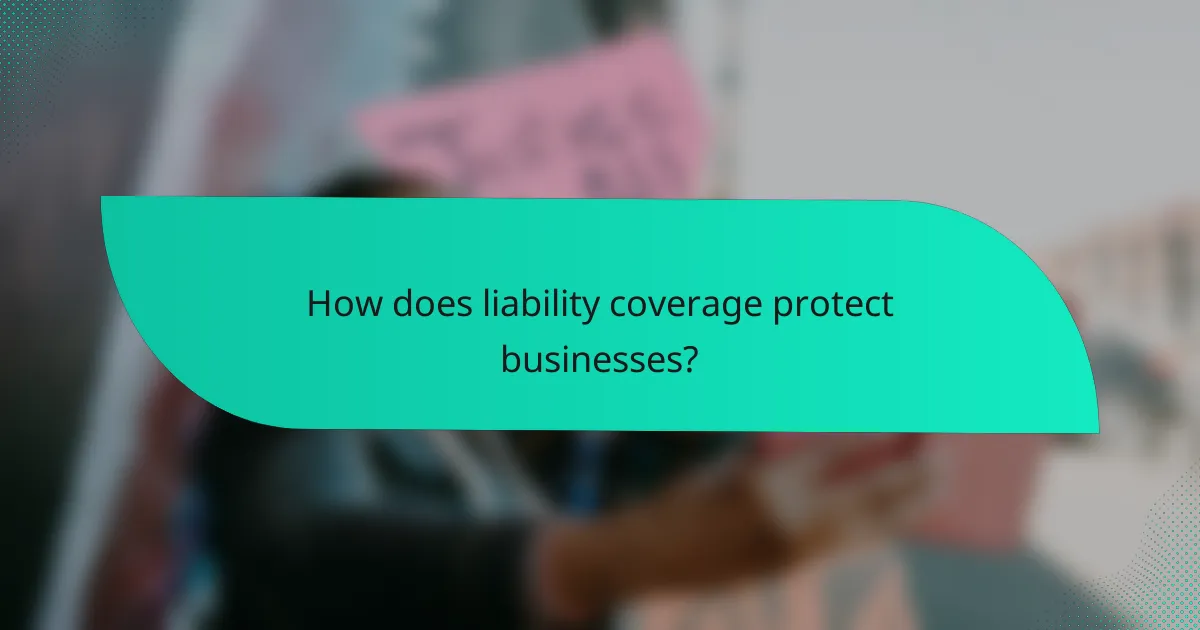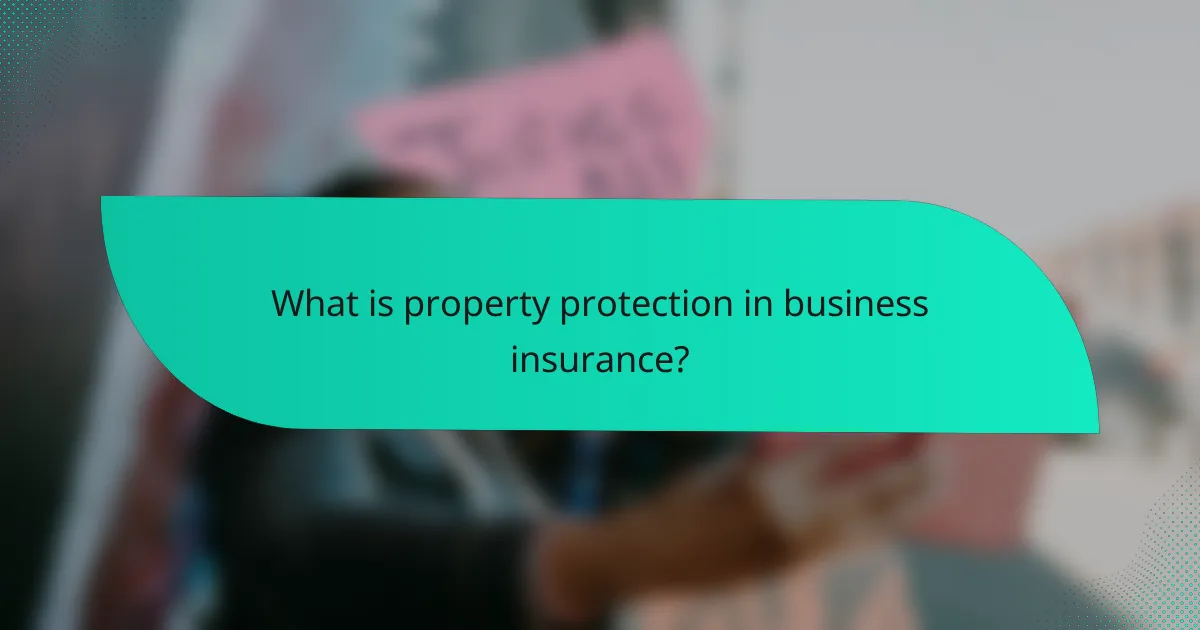Business insurance is crucial for safeguarding companies against potential financial losses, encompassing various types of coverage tailored to different risks. Key components include liability coverage, which shields businesses from claims of negligence and damages, and property protection, designed to protect physical assets from theft or damage. Additionally, employee benefits are vital for attracting and retaining talent while ensuring compliance with legal requirements.

What are the types of business insurance in the United States?
In the United States, business insurance encompasses various types of coverage designed to protect businesses from financial losses. Key types include liability coverage, property protection, employee benefits, business interruption insurance, and cyber liability insurance.
Liability coverage
Liability coverage protects businesses from claims resulting from injuries and damages to other people or property. This type of insurance typically includes general liability, professional liability, and product liability, each addressing different risks associated with business operations.
For example, general liability insurance covers legal fees and settlements if someone is injured on your premises, while professional liability insurance protects against claims of negligence in professional services. Businesses should assess their specific risks to determine the appropriate level of coverage.
Property protection
Property protection insurance safeguards a business’s physical assets, including buildings, equipment, and inventory. This coverage typically includes protection against risks such as fire, theft, and vandalism.
Businesses should consider the value of their assets and the potential risks they face when selecting property insurance. A common approach is to choose a policy that covers the full replacement cost of the assets to ensure adequate protection in the event of a loss.
Employee benefits
Employee benefits insurance encompasses various types of coverage that support the health and well-being of employees. This can include health insurance, dental and vision coverage, and retirement plans.
Offering comprehensive employee benefits can enhance employee satisfaction and retention. Businesses should evaluate their workforce’s needs and budget constraints to design a benefits package that attracts and retains talent while remaining financially viable.
Business interruption insurance
Business interruption insurance provides financial support to businesses that experience a temporary shutdown due to unforeseen events, such as natural disasters or fires. This coverage helps replace lost income and covers ongoing expenses during the interruption period.
When selecting this insurance, businesses should consider their average revenue and fixed costs to determine the appropriate coverage amount. It is crucial to understand the policy’s terms, including the waiting period and duration of coverage.
Cyber liability insurance
Cyber liability insurance protects businesses from financial losses due to data breaches and cyberattacks. This type of insurance covers costs related to data recovery, legal fees, and notification of affected customers.
As cyber threats continue to evolve, businesses should assess their exposure to cyber risks and consider investing in this coverage. Implementing strong cybersecurity measures alongside insurance can provide a comprehensive approach to managing cyber risks.

How does liability coverage protect businesses?
Liability coverage protects businesses from financial losses due to claims of negligence, injury, or damages caused by their operations, products, or employees. This type of insurance is essential for mitigating risks and ensuring that a business can continue operating despite unforeseen legal challenges.
General liability insurance
General liability insurance covers a broad range of claims, including bodily injury, property damage, and personal injury. This policy is crucial for businesses that interact with clients or the public, as it helps protect against lawsuits resulting from accidents or injuries that occur on their premises.
When considering general liability insurance, businesses should assess their specific risks and choose coverage limits that reflect their exposure. Typical coverage limits can range from $1 million to $2 million, depending on the size and nature of the business.
Professional liability insurance
Professional liability insurance, also known as errors and omissions insurance, protects businesses against claims of negligence or inadequate work. This coverage is particularly important for service-oriented businesses, such as consultants, lawyers, and healthcare providers, where the quality of service can lead to claims of financial loss for clients.
Businesses should evaluate their industry standards and potential liabilities when selecting professional liability insurance. Coverage limits often start at $1 million, but higher limits may be necessary for businesses with significant client interactions or high-stakes projects.
Product liability insurance
Product liability insurance protects businesses from claims related to injuries or damages caused by their products. This type of coverage is essential for manufacturers, wholesalers, and retailers, as it helps safeguard against lawsuits stemming from defective products or inadequate warnings.
When purchasing product liability insurance, businesses should consider the types of products they sell and the associated risks. Coverage limits can vary widely, often starting at $1 million, but businesses may need higher limits based on their product range and market reach.

What is property protection in business insurance?
Property protection in business insurance refers to coverage that safeguards a company’s physical assets from risks like theft, damage, or loss. This type of insurance is essential for maintaining operational continuity and financial stability.
Commercial property insurance
Commercial property insurance covers buildings, equipment, and inventory owned by a business. It protects against risks such as fire, vandalism, and certain natural disasters. Businesses should assess their specific needs to determine the appropriate coverage limits and deductibles.
When selecting a policy, consider factors like location, property value, and the types of risks prevalent in your area. For instance, businesses in flood-prone regions may need additional flood insurance as part of their commercial property coverage.
Business personal property coverage
Business personal property coverage protects movable assets, such as furniture, computers, and machinery, that are used in the course of business operations. This coverage is crucial for businesses that rely heavily on equipment and technology.
It typically covers losses due to theft, fire, and other specified perils. Ensure that your policy includes a comprehensive list of covered items and consider adding endorsements for high-value equipment to avoid underinsurance.
Equipment breakdown insurance
Equipment breakdown insurance covers the repair or replacement of machinery and equipment that fails due to mechanical issues, electrical malfunctions, or other breakdowns. This type of coverage is vital for businesses that depend on specialized equipment for their operations.
It can help mitigate the financial impact of unexpected equipment failures, which can lead to costly downtime. Evaluate your equipment’s age and condition to determine if this insurance is necessary, and consider including it in your overall risk management strategy.

What employee benefits are included in business insurance?
Employee benefits included in business insurance typically encompass health insurance, workers’ compensation, and retirement plans. These benefits are essential for attracting and retaining talent while ensuring compliance with various regulations.
Health insurance options
Health insurance options under business insurance can vary widely, including plans like HMOs, PPOs, and high-deductible health plans. Employers often cover a portion of the premium costs, which can range from 50% to 100%, depending on the plan and company policy.
When selecting health insurance, consider the size of your workforce and the specific needs of your employees. Offering multiple plan options can enhance employee satisfaction and help meet diverse healthcare needs.
Workers’ compensation insurance
Workers’ compensation insurance provides coverage for employees who suffer work-related injuries or illnesses. This insurance typically covers medical expenses, rehabilitation costs, and lost wages, ensuring that employees receive necessary support while protecting the business from lawsuits.
Employers should be aware that workers’ compensation requirements vary by state, with some states mandating coverage for all businesses while others have thresholds based on employee count. Regularly reviewing your policy can help ensure compliance and adequate coverage.
Retirement plans
Retirement plans, such as 401(k) or pension plans, are vital employee benefits that help workers save for their future. Employers can choose to match employee contributions, which can significantly enhance the attractiveness of the retirement plan.
When implementing a retirement plan, consider the administrative costs and the potential tax benefits for both the business and employees. Offering a matching contribution can encourage participation and improve employee retention.

What are the prerequisites for choosing business insurance?
Choosing business insurance requires a clear understanding of your specific needs, risks, and the regulatory environment. This foundational knowledge helps ensure that you select the appropriate coverage to protect your assets and operations.
Assessing business risks
Start by identifying the potential risks your business faces, which can include property damage, liability claims, and employee-related issues. Conduct a thorough risk assessment to evaluate both internal and external threats, such as natural disasters, theft, or workplace accidents.
Consider using a risk matrix to prioritize these risks based on their likelihood and potential impact. This will help you focus on the most critical areas when selecting insurance coverage.
Determining coverage needs
Once you have assessed your risks, determine the types of coverage necessary to mitigate those risks. Common types of business insurance include liability coverage, property protection, and employee benefits. Each type addresses different aspects of risk management.
For example, liability coverage protects against claims of negligence, while property protection covers physical assets. Evaluate your business size and industry to estimate coverage limits, often ranging from thousands to millions of dollars depending on your operations.
Understanding state regulations
Familiarize yourself with the insurance regulations specific to your state, as requirements can vary significantly. Some states mandate certain types of coverage, such as workers’ compensation or unemployment insurance, while others may have specific guidelines for liability insurance.
Consult with a local insurance agent or legal expert to ensure compliance with state laws and to understand how these regulations impact your coverage options. This step is crucial for avoiding penalties and ensuring adequate protection for your business.

How do businesses compare insurance providers?
Businesses compare insurance providers by evaluating coverage options, pricing, and customer service. Key factors include the types of policies offered, the insurer’s financial stability, and the ease of claims processing.
Liability coverage
Liability coverage protects businesses from claims resulting from injuries or damages caused by their operations, products, or employees. This type of insurance is essential for mitigating financial risks associated with lawsuits and settlements.
When comparing liability coverage, consider the limits of coverage, exclusions, and the insurer’s reputation for handling claims. For example, general liability insurance typically covers bodily injury and property damage, while professional liability insurance focuses on errors and omissions in professional services.
Property protection
Property protection insurance safeguards a business’s physical assets, including buildings, equipment, and inventory, against risks like fire, theft, and natural disasters. This coverage is vital for maintaining operational continuity after unexpected events.
Evaluate property protection policies based on the types of perils covered, replacement cost versus actual cash value, and any deductibles. For instance, a business might choose a policy that covers specific hazards relevant to its location, such as flood insurance in flood-prone areas.
Employee benefits
Employee benefits insurance encompasses various plans that provide financial protection and support to employees, such as health insurance, disability coverage, and retirement plans. Offering competitive benefits can help attract and retain talent.
When assessing employee benefits, consider the range of options available, costs to the business, and employee preferences. For example, a small business might offer a basic health plan and a retirement savings option to meet employee needs while managing expenses effectively.
